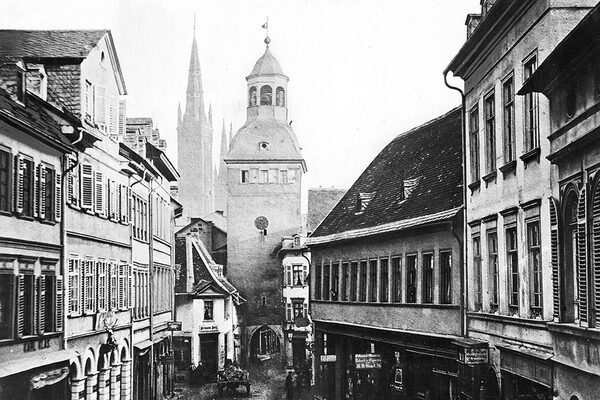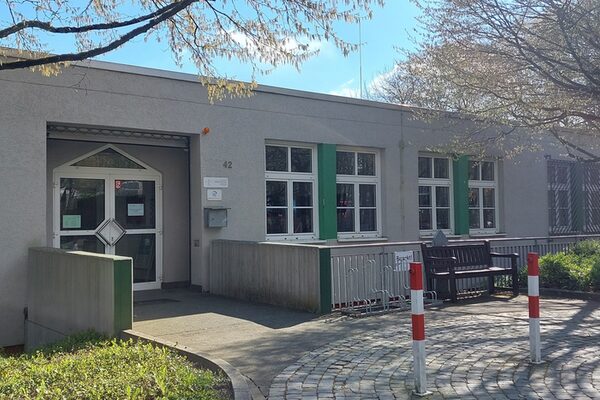History of the Wiesbaden City Archive
The Wiesbaden city archives date back to the 16th century. At the end of the 19th century, Wiesbaden's first full-time city archivist, Christian Spielmann (1861-1917), organized the city archive according to scientific criteria for the first time. Since then, the city archive can look back on around 130 years of history.
From the beginnings to the end of the Spielmann era (1815-1920)
The first known repository for the documents of the city of Wiesbaden was the clock tower in Marktstraße at the beginning of the 16th century. However, the devastating city fire of 1547 destroyed a large part of the city archives from the Middle Ages. In addition, files were destroyed at the beginning of the 18th century due to lack of space. The remaining archive remained in the clock tower and was provisionally organized and indexed by Karl Rossel (1815-1872) in 1850/51.
As Wiesbaden grew rapidly in the course of the 19th century as an up-and-coming spa and residential city, the urban renewal of the city led to the demolition of the clock tower in 1873. The archive was initially housed in the attic chambers of the Old Town Hall (today the Wiesbaden registry office), from 1880 in one of the tower rooms of the Marktkirche and finally from 1892 in the north-eastern tower of the New Town Hall.
After the move to the New Town Hall, the existing documents were organized by Wiesbaden's first city archivist Christian Spielmann (1861-1917) and supplemented by collections. When Spielmann took office in 1892, the Wiesbaden City Archive was established as a modern municipal institution.
Dissolution, refoundation and professionalization (1920-1989)
After Spielmann's death, Lothar Lüstner (1882-1955) took over the management of the city archive for four years in 1920. Due to a lack of space, it was no longer possible to store all of the records in the town hall, which were growing as a result of modern office organization. In addition, the town was under pressure to make savings as a result of the First World War and the decline of the spa business. In 1924, the decision was therefore made to integrate the town archive and its historical holdings into the Nassau State Library, which had been given a new functional building on Rheinstraße in 1913. In 1933, the archive holdings were transferred to the State Archives on Mainzer Straße.
During the Second World War, the oldest parts of the municipal archives were also moved to Ehrenbreitstein Fortress in Koblenz together with the state archives. In April 1944, the remains of the municipal archives were stored in a cellar room of the Hebbelstraße boys' school to protect them from air raids.
The municipal registry, which mainly contained documents from the 1920s and 1930s, remained in the town hall. As a result of the air raid on February 2, 1945 and the deliberate destruction of files in the final weeks of the war, the stock of documents from the Weimar Republic and the "Third Reich" was severely decimated.
After the Second World War, rooms in Schützenhofstraße 4 initially served as emergency quarters for the city archive. With Wilhelm Schauß (1896-1953), a city archivist took over the management of the archive again in 1948. In 1951, the archive then moved into the rebuilt New Town Hall, with former air raid shelters in the basement serving as the main storage area, and Dr. Herbert Müller-Werth (1900-1983) became head of the town archive until his retirement in 1965.
From 1974, Günter Mischewski (1942-2006) managed the archive for 25 years. Mischewski was also the first specialist archivist trained at the Federal Archives to work for the City of Wiesbaden. From 1978 until the end of 1989, the city archive was located in the villa at Humboldtstraße 6, designed by Alfred Schellenberg (1850-1932). However, the listed building only offered inadequate storage facilities for the archive material. In 1987, the working conditions of the archive were significantly improved by the creation of two additional archivist positions. In 1991, the city archive began publishing its own series of publications.
The city archive in the former Rotaprint factory (1990-2020)
The last move of the Wiesbaden City Archive followed in 1990. After an investment of DM 2.5 million, the archive moved into the former production facility of the Rotaprint printing press company, which had been converted to meet the needs of the archive, at the new address "Im Rad 42". Since then, the city archive has had functional office and storage rooms as well as spacious workstations for users. Good public transport connections (ESWE stops "Kleinfeldchen-Stadtarchiv" and "Künstlerviertel-Stadtarchiv") and free parking make it easy to visit.
Since the early 1990s, the City Archive has also been responsible for the memorials and places of remembrance relating to the history of National Socialism in Wiesbaden. Today, this task and historical education work is bundled in the Memorials department.
From 1999 to 2019, Dr. Brigitte Streich took over the management of the city archive and, together with her team, established the city archive as a meeting and cultural venue through numerous historical exhibitions, cooperation with the Kunstarche e.V., which is also housed in the city archive building, and a diverse program of events. Since 2005, the non-profit organization Verein zur Förderung des Stadtarchivs Wiesbaden e.V. has supported the work of the archive.
The indexing of the holdings has been accelerated since 2003, particularly in the area of photos, films and audio recordings, thanks to the establishment of a separate "Multimedia Archive" department. At the same time, the indexing and preservation of the records has been further advanced. The publications in the City Archive's publication series and the Stadtlexikon Wiesbaden, published in 2017, have sustainably strengthened the historiography of the state capital's history.
Today: Our story. In good hands.
Today, the ten permanent employees as well as the project and support staff of the city archive answer around 3,000 usage requests per year and support around 350 users in the reading room, for whom more than 1,000 retrievals and repositioning from the approximately 6.2 kilometers of stacks are carried out. In 2020, around two thirds of the documents stored at the city archive were indexed and therefore available to visitors.
In addition to the file material, the city archive has a large collection of special formats. These include - as of 2021 - a map collection with around 21,500 maps and plans, around 18,500 posters, around 6,000 postcards and fanfolds, 1,700 engravings, 798 videos and audio tapes, 406 other data carriers such as CD-ROMs, and around 104,000 photos as prints, slides, negatives and glass plates.
Since 2020, the archive material has also been searchable via the internet and orders for the reading room can be placed online. In 2021, the legal basis for archive work dating back to the early 1990s, the archive statutes of the state capital of Wiesbaden and the user regulations were also fundamentally amended by the city council.
Contact us
City archive
Address
65197 Wiesbaden
Postal address
65029 Wiesbaden
Arrival
Notes on public transport
Public transportation: Bus stop Kleinfeldchen/Stadtarchiv, bus lines 4, 17, 23, 24 and 27 and bus stop Künstlerviertel/Stadtarchiv, bus line 18.
Telephone
- +49 611 313022
- +49 611 313977
Opening hours
Opening hours of the reading room:
- Monday: 9 a.m. to 12 p.m.
- Tuesday: 9 am to 4 pm
- Wednesday: 9 am to 6 pm
- Thursday: 12 to 16 o'clock
- Friday: closed

